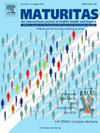Body composition as an index of the trabecular bone score in postmenopausal women
IF 3.9
2区 医学
Q2 GERIATRICS & GERONTOLOGY
引用次数: 0
Abstract
Objective
Obesity is considered to exert a protective effect on bone mineral density (BMD). However, emerging data indicate that the effect of adipose tissue on bone health is much more complex. Trabecular bone score (TBS) provides information on bone texture and predicts fracture risk independently of BMD. This study investigated the association of body composition and bone quality as evaluated by lumbar spine (LS) TBS.
Study design
Cross-sectional study including 118 postmenopausal women (mean age 60.73 ± 8.97 years and mean BMI 28.36 ± 5.8) with no history of secondary osteoporosis or previous anti-osteoporotic treatment.
Main outcome measures
Body composition, BMD and LS TBS were evaluated by dual-energy X-ray absorptiometry (DXA). Τo explore the associations among the variables of interest, Spearman's correlations were used. Simple and multiple linear regression models were also applied to explore the associations among variables of interest.
Results
Visceral adipose tissue (VAT) mass, android fat mass and android/gynoid fat ratio were negative predictors of TBS (Stb = −0.413, p < 0.001; Stb = −0.369, p < 0.001; Stb = −0.333, p < 0.001, respectively). Similarly, both the right (Stb = −0.313, p < 0.001) and left arm fat mass (Stb = −0.313, p < 0.001) were negative predictors of TBS. In a multiple linear regression model, VAT mass exhibited a significant negative association with TBS (Stb = −0.415, p < 0.05).
Conclusions
The present study offers evidence that VAT mass has a negative association with bone texture as estimated by TBS in postmenopausal women. Moreover, the findings suggest that the body composition of the arms (arm fat mass) correlates inversely with the bone texture. Further research is required to validate these findings in large cohorts of postmenopausal women.
身体成分作为绝经后妇女小梁骨评分的指标
目的肥胖被认为对骨密度(BMD)具有保护作用。然而,新出现的数据表明脂肪组织对骨骼健康的影响要复杂得多。骨小梁评分(TBS)提供骨质地信息,并独立于BMD预测骨折风险。本研究探讨了腰椎(LS) TBS评估的身体成分和骨质量的关系。研究设计横断面研究纳入118名绝经后妇女(平均年龄60.73±8.97岁,平均BMI 28.36±5.8),无继发性骨质疏松史或既往抗骨质疏松治疗。主要观察指标采用双能x线吸收仪(DXA)评估体成分、骨密度和LS TBS。Τo探索感兴趣的变量之间的联系,斯皮尔曼的相关性被使用。简单和多元线性回归模型也被用于探索感兴趣的变量之间的关联。结果内脏脂肪组织(VAT)质量、android脂肪质量和android/gynoid脂肪比是TBS的负相关预测因子(Stb = - 0.413, p <;0.001;Stb =−0.369,p <;0.001;Stb = - 0.333, p <;分别为0.001)。同样,右(Stb = - 0.313, p <;0.001)和左臂脂肪量(Stb = - 0.313, p <;0.001)为TBS的阴性预测因子。在多元线性回归模型中,增值税质量与TBS呈显著负相关(Stb = - 0.415, p <;0.05)。结论本研究提供的证据表明,经TBS评估,绝经后妇女的VAT质量与骨质呈负相关。此外,研究结果表明,手臂的身体组成(手臂脂肪量)与骨质呈负相关。需要进一步的研究来验证这些发现在绝经后妇女的大队列。
本文章由计算机程序翻译,如有差异,请以英文原文为准。
求助全文
约1分钟内获得全文
求助全文
来源期刊

Maturitas
医学-妇产科学
CiteScore
9.10
自引率
2.00%
发文量
142
审稿时长
40 days
期刊介绍:
Maturitas is an international multidisciplinary peer reviewed scientific journal of midlife health and beyond publishing original research, reviews, consensus statements and guidelines, and mini-reviews. The journal provides a forum for all aspects of postreproductive health in both genders ranging from basic science to health and social care.
Topic areas include:• Aging• Alternative and Complementary medicines• Arthritis and Bone Health• Cancer• Cardiovascular Health• Cognitive and Physical Functioning• Epidemiology, health and social care• Gynecology/ Reproductive Endocrinology• Nutrition/ Obesity Diabetes/ Metabolic Syndrome• Menopause, Ovarian Aging• Mental Health• Pharmacology• Sexuality• Quality of Life
 求助内容:
求助内容: 应助结果提醒方式:
应助结果提醒方式:


